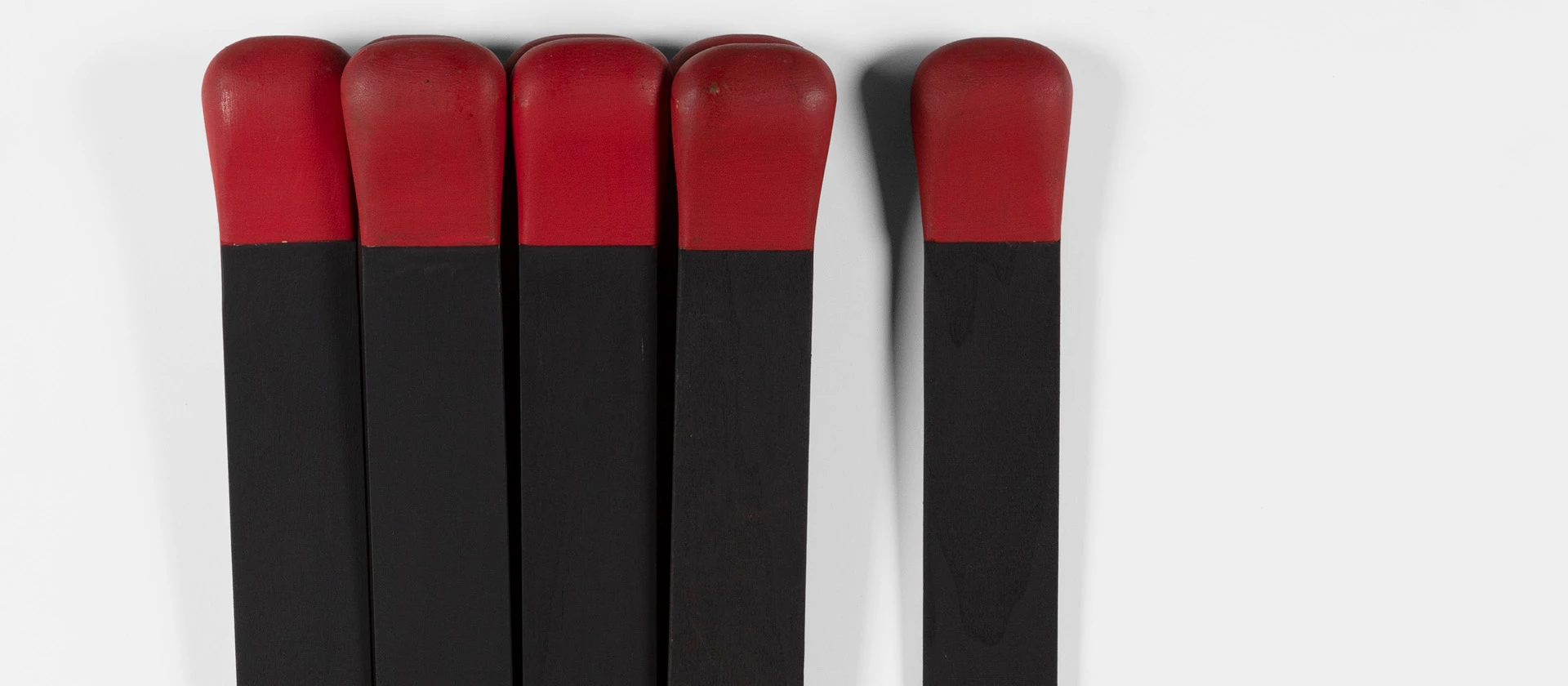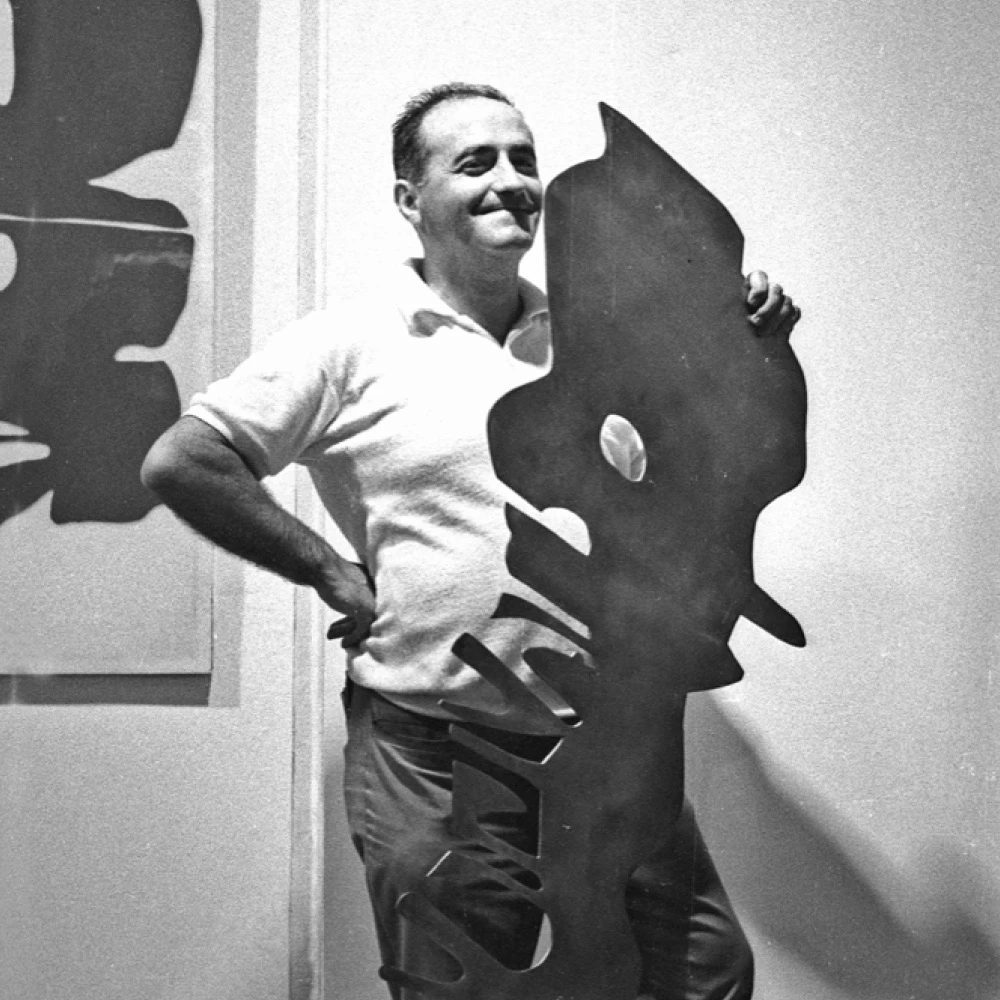Raymond Hains was born in Saint-Brieuc, Brittany, in 1926. While studying fine arts in Rennes, he befriended Jacques Villeglé. In 1945, Hains moved to Paris, where he started to frequent the artistic and literary circles of the avant-garde. He began experimenting with the darkroom and executing his hypnagogic photographs, which were exhibited in 1948 in Hains’s first solo exhibition at the Galerie Colette Allendy. With the help of Villeglé, Hains designed the Hypnagogoscope, a movie-camera-machine with ribbed glass lenses. Using this machine, from 1950 to 1954 Hains and Villeglé collaborated on an ambitious project for an abstract color film titled Pénélope, which was left unfinished.
In 1949, Hains conceived one of the founding gestures of the Nouveau Réalisme: the décollage (unpeeling) of torn posters. While he was filming shorts in Paris, his eye strayed to a wall covered with posters. He decided to detach a fragment and bring it home. According to Hains, the affiches lacerées - layered fragments of torn posters recovered from the streets – were the work of a multitude of anonymous passers-by and the product of the city itself. They realized the utopian idea of a collective work created “by everybody and not by Hains” (or “by one”: in French, Hains is pronounced like un = one). The torn posters made their first public appearances in three exhibitions: Loi du 29 juillet 1881 ou Le lyrisme à la sauvette at the Galerie Colette Allendy in 1957, Lacéré anonyme at Ginette and François Dufrêne’s apartment and La France déchirée at Galerie J, where he exhibited with Villeglé about twenty political posters documenting the Algerian war. In 1960, Hains was one of the signatories of the Nouveau Réalisme manifesto.
At the end of the 1950s, Hains started to collect and display boarding fences from construction sites, the so-called palissades. In 1959, during the Paris Biennale at the Musée d’Art Moderne de la Ville de Paris, Hains created a scandal by exhibiting his first wooden palisade barrier, the Palissadedes emplacements réservés. In 1961, a torn poster by Hains and Villeglé was shown at MoMA in William Seitz’s legendary exhibition The Art of Assemblage. The following year, Sydney Janisshowed one of Hains’s tôles – posters on galvanized steel – in the exhibition The New Realists, alongside works by Claes Oldenburg, Jim Dine and Andy Warhol’s Campbell Soups.
Between 1964 and 1971, Hains lived mainly in Italy. In Venice, he continued to harvest torn posters, often with an artistic connotation, some of which were included in the exhibition La Biennale déchirée at the Galleria Apollinaire in Milan in 1965 and at the Galleria del Leone in Venice the following year. In Venice, Hains continued experimenting with the Hypnagogoscope and executed his Fer de gondoles (Gondola irons) using the reflections of the gondola-prow (ferro di prua) on the canals. In 1968, Hains distorted the catalogue covers of the country-pavilions at the Biennale using fluted lenses. The results were transposed into large colored Plexiglass reliefs, which were included in the exhibition La Biennale éclatée at the Galleria dell’Elefante in 1968.
The most notable works from this Italian period were the matches Saffa and Seita – mural or three-dimensional wooden matchbooks – which Hains began making in 1964. The artist took inspiration from Oldenburg and, simultaneously, from the boxes of matches that Venetian restaurants, such as L’Angelo or La Colomba, used to give to their guests as souvenirs. The matches were exhibited at the Galerie Iris Clert in Paris in 1965 and were on the cover of Life in 1966 to mark the magazine’s Yves Saint Laurent fashion shoot.
In the second half of the 1960s, the immaterial took an increasingly important role in Hains’s work. Associations of ideas became his principal raw material and the objects he invented were symbolic references and sequences of meaning. In 1976, Pontus Hulten organized the first major retrospective of Hains’s work, La chasse au CNACat the Centre National d’Art Contemporain (which was to move to the Centre Pompidou the following year). In the same year, Hains exhibits in the French Pavilion at the Venice Biennale. In the 1980s and 1990s, Hains had exhibitions that were works of art in themselves by mixing installation and sculpture with photographs and ex-tracts from books. These included: Le Monochrome dans le Metro at the Galerie Eric Fabre in 1983, a touring exhibition in 1989 that took him from the Musée Sainte-Croix in Poitiers to MoMA PS1 in New York, and Les 3 Cartier at Fondation Cartier in Paris in 1994. In the late 1990s, Hains developed the macintoshages, computer-based works consisting of a combination of digital images.
In 2001-2002, the Centre Pompidou staged a major Hains retrospective, Le Tentative, which later moved to the Moore College of Art in Philadelphia. In 2005, Hains made a series of neon sculptures based on Jacques Lacan’s Borromean rings. He died in October of that year at the age of 79. In 2017, the 57th Venice Biennale Viva Arte Viva paid homage to the artist by exhibiting a selection of his works in the Central Pavilion at the Giardini.

